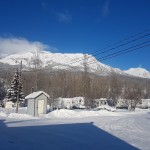RVing in the Winter
 These days we are seeing more and more RVers using their RVs in the cold Winter months. There isn’t much of a difference if you are travelling down south to a warmer climate; however if you plan on staying in Canada for the winter there are some things that we reccomend to keep your RV home warm in the cold winter months.
These days we are seeing more and more RVers using their RVs in the cold Winter months. There isn’t much of a difference if you are travelling down south to a warmer climate; however if you plan on staying in Canada for the winter there are some things that we reccomend to keep your RV home warm in the cold winter months.
First of all, we reccomend using good quality skirting for your RV. There are many ways to do this from buying pre-made skirting to building your own.
DIY Skirting:
1. Plywood – Pros – Sturdy, durable, and inexpensive.
Cons- Not easy to move and doesn’t look very good (paint to match unit).
2. Foam Board Insulation – 2” or more in thickness.
– Pros- Inexpensive and good insulator if set up correctly.
Cons- Not easy to move, not very sturdy (reinforce with plywood), and doesn’t look good (cannot be painted).
3. Hay Bales – Pros – Very Inexpensive and great insulation.
– Cons- Hay will mold when wet, is usually full of everything you don’t want in your RV (mice, spiders, etc), and doesn’t look good at all (very unlikely that a park would let you have hay as your insulator).
Vinyl – Pros – Easily movable if set up correctly and moderate cost (usually under $1000).
– Cons – Lower insulation value, takes time to slide all the pieces together (can be very difficult if ground is uneven or you don’t have experience with vinyl skirting).
Professional Skirting:
1. EZ Snap Skirting – Pros – Easily movable and looks great.
– Cons – May have lower insulation value (ask), and can be quite pricey.
2. RVSkirting.com – Pros – Custom fit, great insulator, easy to move, and relatively hassle free.
– Cons – Expensive ($3000+ range).
After you have your skirting figured out you should ensure your water does not freeze. In order to avoid freezing directly at the connection you may be able to build a box out of plywood to cover the area (depending on your park rules). Then purchase heat tape, pipe insulation or a heated water hose for your city water line(s). Your sewer line can be easily heated if necessary with heat tape (unhooking the sewer line after dumping and storing it in a basement compartment can help this matter). If it gets really cold in your area the water tanks can be heated as well with an RV specific tank heater.
Next you can consider insulating windows, doors and roof vents. Sometimes RVers will only insulate large windows due to the blocking of sunlight.
Windows: ***** dual sided tape and good quality stretch window film insulation
*** cut out Styrofoam blocks to fit (awkward and block sunlight)
*** sew custom window coverings with insulating properties.
** Keep curtains/blinds closed.
Doors: Door window cover
Roof Vents: ***** – Vent Shield – Custom fit to cover 14X14 roof vents.
*** – Cut Styrofoam to fit roof vents (can fall down if not fitted properly).
After everything is sealed off you will notice an increase in humidity in the unit. The best thing to do in this case is get some moist remover in the unit. The moist remover will collect the moisture from the air in the bucket or dry-it bag leaving you to dump the bucket/throw out the dry-it bag and refill/replace. If condensation is left in the unit it may cause damage to the unit.
The moist remover will collect the moisture from the air in the bucket or dry-it bag leaving you to dump the bucket/throw out the dry-it bag and refill/replace. If condensation is left in the unit it may cause damage to the unit.
Heating the unit will cost more in the winter months. In order to get better value for the propane and to avoid the hassle of constantly filling up cylinders rent/purchase a large propane tank. Low Cost Propane in our area delivers & refills these cylinders when RVers use their propane. If you are looking to refill propane cylinders locally Fernie Rentals refills propane tanks.
Once all this is done your RV is ready to handle almost everything in the cold weather winter in Canada brings!
– Lindsey Roberts
*Please note that these are just suggestions and are in no way guaranteed to keep your unit from freezing in cold weather.
Lindsey Roberts
Snowy Peaks RV

